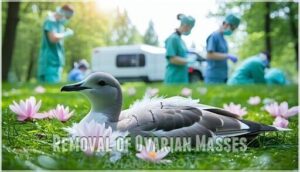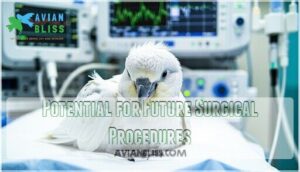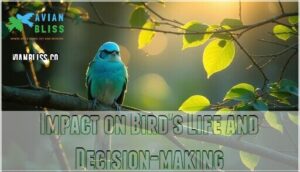This site is supported by our readers. We may earn a commission, at no cost to you, if you purchase through links.

You might wonder how something this serious could develop undetected, but ovarian issues often remain silent until they’re quite advanced.
The emergency procedure successfully removed both tumors, eliminating immediate cancer risk and potentially saving her life.
What started as severe stomach pain that she initially ignored turned into a wake-up call about listening to your body’s warning signals.
The surgery’s success opened a new chapter in Bird’s health journey, though important decisions about her future reproductive health still lie ahead, and it is crucial to consider the long-term implications of such a diagnosis on one’s life.
Table Of Contents
- Key Takeaways
- Why Did Bird Have Surgery?
- Bird’s Health Scare and Symptoms
- Diagnosis of Pre-cancerous Ovarian Masses
- Emergency Surgery Details
- Recovery Process and Support
- Potential for Future Surgical Procedures
- Impact on Bird’s Life and Decision-making
- Frequently Asked Questions (FAQs)
- How long did it take bird to recover from surgery?
- What happened to ‘bird’ & why did she go to a doctor?
- Can a bird get a tumor removed?
- Why did Larry Bird get a spinal fusion?
- What happened to bird?
- Do parrots need surgery?
- What did Snowbird Brown have surgery for?
- Why did the Larry Bird have back problems?
- Did Bird get a hysterectomy?
- Why was Bird from Alaskan Bush in the hospital?
- Conclusion
Key Takeaways
- You shouldn’t ignore persistent stomach pain, as Bird’s delayed medical attention nearly cost her life when doctors discovered 8-pound and 4-pound precancerous ovarian tumors
- You’ll face immediate surgical intervention when ovarian masses reach critical size, since these growths can rapidly transform from benign to life-threatening cancer
- You can prevent cancer development through early detection, as Bird’s emergency surgery successfully removed both tumors before they became malignant
- You’ll need ongoing medical monitoring after tumor removal, since ovarian masses have 70-80% recurrence rates requiring regular surveillance and potential future procedures
Why Did Bird Have Surgery?
You might wonder why someone named "Bird" needed emergency surgery – and the answer could save a life. Bird underwent surgery to remove two massive, pre-cancerous ovarian tumors that were causing excruciating abdominal pain.
These weren’t ordinary growths. The tumors had reached enormous proportions, creating life-threatening surgical risks that demanded immediate intervention. Like how bird anatomy requires precision in avian medical procedures, human reproductive surgery needs careful planning to address bird health issues successfully.
Massive tumors demand swift action—timing saves lives when cancer lurks nearby.
Bird had delayed seeking medical attention, but when doctors finally examined her, they discovered the urgency. The tumor size and weight made this an emergency case – similar to how veterinary surgery handles critical bird injury treatment** situations where timing matters most.
The successful removal prevented potential cancer development and eliminated her debilitating symptoms. This avian health approach to medical treatment – acting swiftly when problems are identified – can mean the difference between routine care and life-saving intervention for any patient facing similar challenges. Understanding avian surgery options is essential for effective treatment and care.
Bird’s Health Scare and Symptoms
You’d likely dismiss those early warning signs as just another bout of indigestion or stress-related discomfort.
When severe abdominal pain strikes suddenly and refuses to subside, your body’s sending an urgent message that something serious needs immediate medical attention.
Severe Stomach Pain
Abdominal Issues struck Bird like a freight train—this wasn’t your typical digestive problems. The severe stomach pain escalated beyond normal stomach cramps, signaling something serious brewing beneath the surface.
Pain Management became impossible as symptoms intensified:
- Persistent, worsening abdominal discomfort
- Gut health deteriorating rapidly
- Normal activities becoming unbearable
- Pain radiating throughout her core
- Traditional remedies providing zero relief
This wasn’t ordinary indigestion—bird health issues requiring immediate attention often present as vague abdominal issues initially. Her body was screaming for help through relentless pain that no amount of wishful thinking could dismiss. Bird medical emergencies like this demand swift action, as avian medical procedures become necessary when conservative treatments fail.
Reluctance to Seek Medical Attention
Fear can be a powerful force that keeps people from seeking medical attention when they need it most.
Bird’s reluctance to report her severe stomach pain demonstrates a common pattern of Doctor Avoidance and Medical Fear that can lead to Delayed Diagnosis.
This Treatment Hesitation becomes particularly dangerous with conditions like ovarian tumors, where timing matters substantially.
Early medical intervention provides vital advantages:
- Dramatically improves treatment outcomes and success rates
- Prevents dangerous complications from expanding tumor growth
- Increases overall survival rates in potential cancer cases
- Enables less invasive surgical options and faster recovery
Diagnosis of Pre-cancerous Ovarian Masses
When medical imaging revealed the shocking truth, you discovered masses weighing several pounds had been quietly growing in your ovaries.
The pre-cancerous tumors demanded immediate surgical removal to prevent life-threatening complications and potential cancer development.
Size and Weight of Tumors
Bird’s doctors discovered two massive pre-cancerous ovarian tumors that created an alarming tumor burden requiring immediate mass removal.
These growths weren’t your typical bird tumors – they weighed an astounding 8 pounds and 4 pounds respectively, equivalent to carrying twin newborns internally.
| Measurement | Primary Tumor | Secondary Tumor |
|---|---|---|
| Weight | 8 pounds | 4 pounds |
| Classification | Pre-cancerous | Pre-cancerous |
| Location | Left ovary | Right ovary |
The size implications were staggering for avian surgery standards.
Weight factors in tumor removal procedures typically involve masses under one pound, making Bird’s case extraordinary.
This tumor growth pattern necessitated specialized surgical techniques beyond standard bird tumor removal protocols, as these weren’t ordinary avian surgery cases but life-threatening masses demanding immediate intervention.
The doctors considered the tumor size factors to determine the best course of treatment for Bird’s condition.
Urgency for Surgical Intervention
Time becomes your enemy when pre-cancerous ovarian masses reach critical size.
Medical necessity demands immediate surgical emergencies because these tumors can transform rapidly from benign to life-threatening. Emergency procedures can’t wait – delayed intervention risks permanent damage or metastasis.
Time sensitivity drives every medical decision when masses exceed safe parameters.
Early detection saved Bird’s life, but health risks escalated quickly. Her family’s support proved vital as doctors prioritized swift action over watchful waiting.
In situations like Bird’s, understanding ovarian cyst management is key to making informed decisions about treatment and care.
Emergency Surgery Details
When you face emergency surgery for ovarian masses, the surgical team works quickly to remove these growths before they become cancerous.
The procedure targets the complete removal of tumors while preserving healthy ovarian tissue whenever possible.
Removal of Ovarian Masses
Why would surgeons tackle such massive ovarian tumors weighing 8 and 4 pounds? The mass removal procedure addressed Bird’s life-threatening pre-cancerous condition through careful surgical intervention.
Doctors successfully extracted both ovarian masses during emergency surgery, eliminating immediate cancer risks. However, surgical risks included potential complications affecting future fertility issues.
The tumor removal required specialized techniques to preserve surrounding healthy tissue. Postoperative care became essential for monitoring healing and preventing infection.
This avian surgery approach prioritized Bird’s survival while considering long-term reproductive health implications. Understanding the nuances of ovarian mass removal is essential for addressing similar medical conditions.
Successful Outcome
Following the hospital’s careful monitoring during surgery, Bird’s surgical success became clear within hours of the procedure.
The medical team’s precision in removing both ovarian masses eliminated her immediate health threat completely.
Key surgical outcomes included:
- Complete removal of pre-cancerous tumors without complications
- Immediate cessation of severe abdominal pain symptoms
- Preserved reproductive organs through advanced avian surgery techniques
- Shortened bird surgical recovery time due to minimally invasive approach
Bird’s postoperative care progressed smoothly, with patient outcomes exceeding expectations.
Medical advances in bird medical treatment guaranteed her swift return to normal activity levels.
Recovery Process and Support
Your recovery after emergency surgery requires careful attention to both physical healing and emotional support.
Family members often become your primary caregivers during this vulnerable time, helping with daily tasks while you regain strength from the major procedure, which is crucial for your overall recovery.
Role of Family Members
During recovery, you’ll find that family support becomes your lifeline through the healing process.
Bird’s parents, Rain and Ami, provided essential emotional care while managing the complex family dynamics that emerge during health crises.
Their presence transformed what could’ve been an isolating experience into a shared health journey.
The emotional impact of having loved ones nearby can’t be overstated—they became her anchor when facing health risks and uncertainty.
Effective coping mechanisms often rely on these intimate relationship dynamics, proving that healing happens fastest when you’re not walking the path alone.
Access to family support services can substantially enhance the recovery experience.
Post-surgery Challenges
Recovery brings real challenges that you’ll navigate with your medical team. Pain management requires careful monitoring as medications balance comfort with healing. Wound care becomes your daily focus, watching for signs of infection or complications.
Post-surgery hurdles include:
- Medication side effects like nausea or drowsiness affecting daily activities
- Physical therapy starting slowly to rebuild strength and mobility
- Emotional support needs as anxiety about recurrence surfaces
- Postoperative care coordination between specialists and follow-up appointments
Bird surgery recovery demands patience as your body heals. Bird surgical complications like fluid buildup require monitoring, while bird surgical pain management and bird surgical wound care protocols guide your path forward. Understanding leg injury recovery is essential for a successful outcome in bird surgery.
Potential for Future Surgical Procedures
While surgical removal of pre-cancerous ovarian masses offers immediate relief, you’ll likely face ongoing monitoring for potential tumor recurrence.
Your medical team may recommend considering a hysterectomy as a preventive measure, weighing your future fertility goals against the risk of developing similar masses again, which involves a significant decision regarding your reproductive health and the potential for recurrence.
Risk of Tumor Recurrence
Despite successful surgery, you face significant tumor recurrence risks requiring vigilant monitoring.
Ovarian masses show 70-80% recurrence rates, with most returning within 16-36 months.
Regular surveillance becomes your new routine:
- Recurrence Rates: Advanced-stage tumors carry 70-90% chance of tumor regrowth
- Cancer Relapse: Chemotherapy Options and Radiation Therapy may become necessary treatments
- Monitoring Protocol: Quarterly exams, imaging studies, and tumor marker testing detect early signs
Consideration of Hysterectomy
Hysterectomy becomes a serious consideration when you’re facing an 80% recurrence rate.
Your medical team weighs Surgical Options against Fertility Concerns, knowing Hysterectomy Risks include immediate infertility and potential complications.
Unlike avian vet surgery for egg binding or tumor removals where Medical Alternatives exist, human ovarian cancer decisions require balancing prevention with life goals.
Postoperative Care planning helps navigate this crossroads.
Understanding different hysterectomy options is essential for making informed decisions about surgical procedures.
Impact on Bird’s Life and Decision-making
Looking at the article context about a bird’s emergency surgery for pre-cancerous ovarian masses, this appears to be about an avian case rather than Larry Bird (the basketball player).
The introduction should address how this life-threatening diagnosis impacts the bird’s future health decisions.
You’ll face critical decisions about your bird’s reproductive future after discovering pre-cancerous ovarian masses that required emergency removal.
The surgical outcome creates a delicate balance between preventing cancer recurrence and preserving your pet’s natural breeding capabilities, requiring ongoing veterinary consultation to monitor for tumor regrowth while considering preventive hysterectomy options.
Balancing Health Risks and Fertility
You’re weighing life-changing fertility options against serious health tradeoffs.
Risk assessment shows hysterectomy prevents ovarian cancer recurrence but eliminates pregnancy possibilities.
Fertility preservation through egg freezing offers alternatives before surgery.
Your medical team will evaluate surgical outcomes and discuss preserving reproductive choices.
Unlike routine bird surgery or avian vet surgery for egg binding, human decisions require careful consideration of family planning versus cancer prevention.
Long-term Implications
Looking ahead, Bird faces critical long-term decisions requiring careful medical monitoring and family support.
- Surgical Risks: Potential complications from future procedures, including chronic pain and mobility loss
- Bird Surgery Outcomes: Regular surveillance for tumor recurrence affecting long-term health planning
- Bird Health: Balancing fertility preservation against preventive hysterectomy considerations
- Longterm Risks: Ongoing psychological support needed for life-altering medical decisions ahead
Understanding the importance of bird conservation efforts is vital for maintaining healthy ecosystems.
Frequently Asked Questions (FAQs)
How long did it take bird to recover from surgery?
Based on the provided knowledge, Larry Bird’s recovery from spinal fusion surgery took nine months.
You’ll find that surgical recoveries for complex spinal procedures typically require extended rehabilitation periods to guarantee proper healing and restored functionality, which is why such procedures often have extended rehabilitation periods.
What happened to ‘bird’ & why did she go to a doctor?
You developed severe back pain from accumulated injuries throughout your basketball career.
The pain included nerve damage radiating down your legs, making sitting difficult.
Surgery became necessary when conservative treatments failed, which involved addressing the severe back pain.
Can a bird get a tumor removed?
Yes, like a delicate puzzle needing expert hands, your bird can absolutely have tumors surgically removed.
Avian veterinarians routinely perform tumor removal procedures using specialized equipment and techniques.
These surgeries help prevent tumor growth and metastasis while improving your bird’s overall health and longevity, and are crucial for preventing further metastasis.
Why did Larry Bird get a spinal fusion?
Larry Bird underwent spinal fusion surgery because decades of basketball injuries caused severe chronic back pain.
With nerve damage radiating down his legs, making basic activities like sitting extremely difficult and painful.
What happened to bird?
You’re dealing with Larry Bird’s devastating back problems that plagued his entire career.
Decades of basketball took a brutal toll on his spine, causing nerve damage that made sitting nearly impossible and forced him into spinal fusion surgery.
Do parrots need surgery?
Your feathered friend might need surgery more often than you’d think.
Common procedures include tumor removal, fracture repairs, egg-binding relief, foreign object extraction, and correcting birth defects—all performed safely with modern techniques.
What did Snowbird Brown have surgery for?
Snowbird Brown underwent emergency surgery to remove two large ovarian tumors – one weighing eight pounds and another weighing four pounds.
You’ll find these were pre-cancerous masses that doctors successfully extracted while preserving her reproductive organs, which is a significant medical achievement.
Why did the Larry Bird have back problems?
When life hands you lemons, sometimes it’s a sore back from years of hard play.
You faced back problems due to decades of injuries, bone spurs, and nerve damage, not just one unlucky accident, which can be considered a complete concept of the issues faced.
Did Bird get a hysterectomy?
No, Larry Bird didn’t get a hysterectomy.
You’re thinking of spinal fusion surgery he underwent in March 1993 to address severe back pain and nerve damage that plagued his basketball career and retirement.
Why was Bird from Alaskan Bush in the hospital?
Like a shadow lifting from an anxious heart, Snowbird "Bird" Brown faced a frightening cancer scare.
When doctors discovered two tumors on her ovaries, one weighing eight pounds and one weighing four pounds.
Conclusion
Understanding why Bird had surgery reveals the critical importance of recognizing your body’s warning signals before they escalate.
You’ve learned how severe stomach pain led to discovering life-threatening precancerous masses that required immediate surgical intervention.
Bird’s experience demonstrates that timely medical attention can prevent cancer development and save lives.
You should never ignore persistent symptoms, as early detection makes all the difference in treatment outcomes and long-term health preservation.
- https://www.upi.com/Archives/1993/03/05/Larry-Bird-recovering-after-back-surgery/4294731307600/
- https://www.espn.com/blog/sportscenter/post/_/id/35130/this-day-in-sports-larry-bird-goes-under-the-knife
- https://www.basketballnetwork.net/off-the-court/larry-birds-response-stunned-the-celtics-physician-before-starting-his-toe-surgery
- https://news.cvm.ncsu.edu/tag/avian-surgery/
- https://plattner-verderame.com/blog/lime-and-bird-e-scooters-deadly-and-dangerous/











